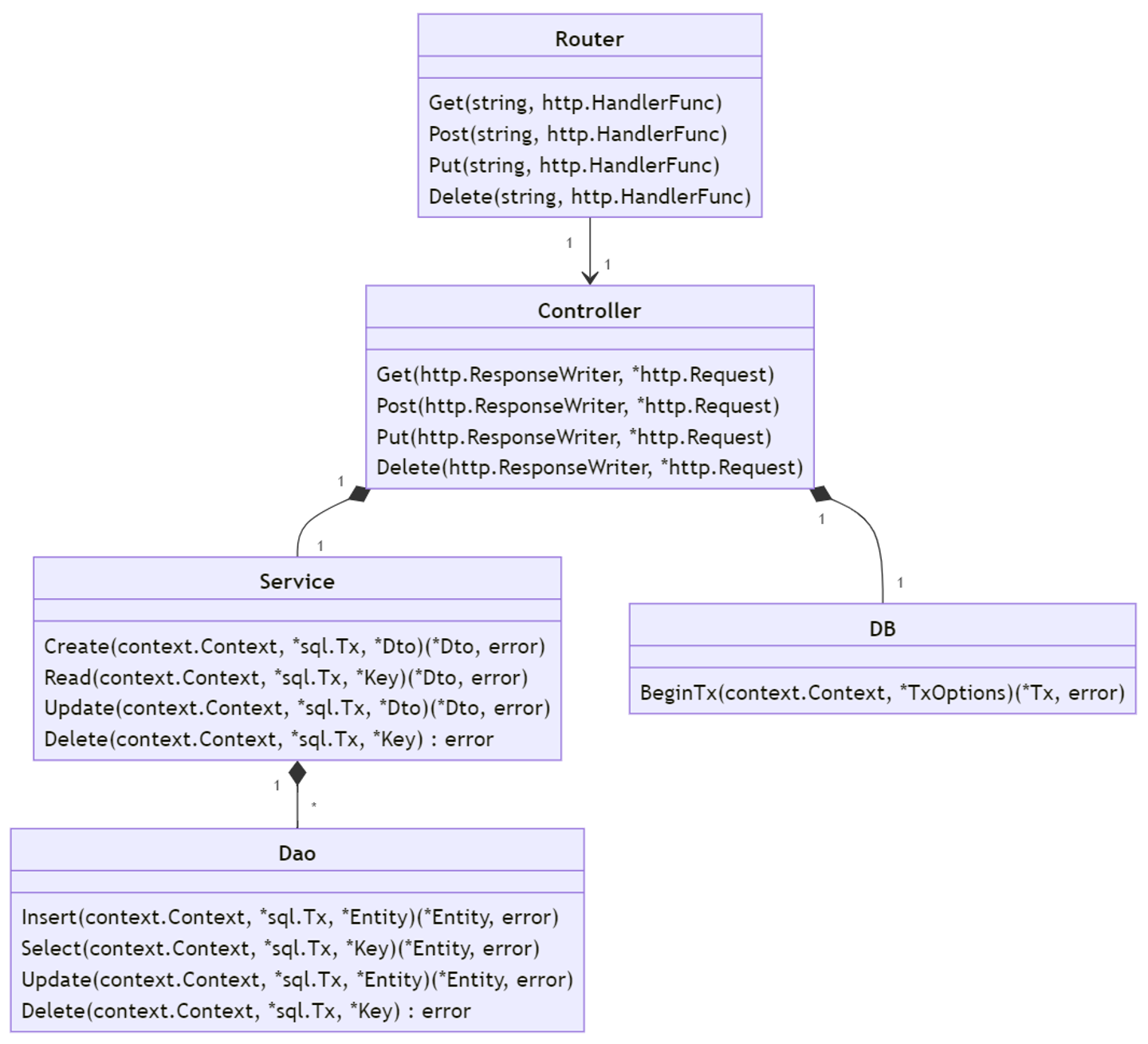はじめに
NestJS、FastAPIに続いて、GolangでもRESTサーバーを開発しましたという記事です。過去の記事は、以下から参照ください。
設計
ライブラリやフレームワーク
NestJSやFastAPIについては、フレームワークありきで実装してきました。Golangの場合は、まずは、できるだけ標準ライブラリでいきたかったのですが、実装してみて、パスパラメータやルーティングの構成を自力でやるのは、なかなか大変そうに感じたので、go-chiだけは使わせてもらうことにしました。
また、データベースも上記のNestJS、FastAPIの際と同じPostgeSQLを使用します。
構造
GolangにはClassは無いので、Class図というのも変かもしれませんが、NestJSに影響されて(笑)、上記のNestJSやFastAPIの実装に近い構造にしました。RESTリソース単位に以下のセットを追加していくことにします。
![]()
実装
環境
別件で使用中の環境で実装しました。
$ go version
go version go1.18.6 linux/amd64
$ go version
go version go1.18.6 linux/amd64
module github.com/take0a/go-rest-sample
go 1.18
require (
github.com/go-chi/chi/v5 v5.0.8
github.com/go-chi/render v1.0.2
github.com/lib/pq v1.10.7
)
require github.com/ajg/form v1.5.1
module github.com/take0a/go-rest-sample
go 1.18
require (
github.com/go-chi/chi/v5 v5.0.8
github.com/go-chi/render v1.0.2
github.com/lib/pq v1.10.7
)
require github.com/ajg/form v1.5.1
データ構造
RESTリソースをJSONで入出力するデータ構造は、DTO(Data Transfer Object)という命名規則にしました。DTOにはJSONタグを付与します。また、複合キーのケースも想定して主キーも構造体にしました。
データベースと入出力するデータ構造は、Entityという命名規則にしました。今回の場合は、基本的にほぼ同じ型になるのですが、相互に変換するための処理を実装します。
package customers
type Key struct {
CustomerID int
}
type Dto struct {
CustomerID int `json:"customerId"`
Name string `json:"name"`
Address string `json:"address"`
}
func NewDto(customer *Entity) *Dto {
return &Dto{
CustomerID: customer.CustomerID,
Name: customer.Name,
Address: customer.Address,
}
}
func (c *Dto) Key() *Key {
return &Key{
CustomerID: c.CustomerID,
}
}
package customers
type Key struct {
CustomerID int
}
type Dto struct {
CustomerID int `json:"customerId"`
Name string `json:"name"`
Address string `json:"address"`
}
func NewDto(customer *Entity) *Dto {
return &Dto{
CustomerID: customer.CustomerID,
Name: customer.Name,
Address: customer.Address,
}
}
func (c *Dto) Key() *Key {
return &Key{
CustomerID: c.CustomerID,
}
}
package customers
type Entity struct {
CustomerID int
Name string
Address string
}
func NewEntity(dto *Dto) *Entity {
return &Entity{
CustomerID: dto.CustomerID,
Name: dto.Name,
Address: dto.Address,
}
}
package customers
type Entity struct {
CustomerID int
Name string
Address string
}
func NewEntity(dto *Dto) *Entity {
return &Entity{
CustomerID: dto.CustomerID,
Name: dto.Name,
Address: dto.Address,
}
}
名前があっさりしているのは、Golangの場合、パッケージ名+要素でアクセスすることが多いこともあって、パッケージ名を含めた名前を公開するとlinterに注意されたりしますし、短い単語を使うのがGolangらしいかなということで、Golangに馴染みのない方からすると違和感満載かもしれません。
また、識別子の多くが大文字で始まっていてパッケージ外に公開されているのは、いろいろと試行錯誤している途中の段階でもあり、最適ではありません。
DAO(Data Access Object)
DTOといい、Javaの香りがするかもしれませんが、これは、エンタープライズアプリケーションアーキテクチャパターンのテーブルデータゲートウェイパターンなのだ。と言ってもDAOの方が通りが良いような気がしたので、DAOにします。
package customers
import (
"context"
"database/sql"
"log"
"github.com/lib/pq"
"github.com/take0a/go-rest-sample/utils"
)
const (
Insert = `
INSERT INTO CUSTOMER (
CUSTOMER_ID, NAME, ADDRESS
) VALUES (
$1, $2, $3
)`
Select = `
SELECT
CUSTOMER_ID, NAME, ADDRESS
FROM CUSTOMER
WHERE CUSTOMER_ID = $1`
Update = `
UPDATE CUSTOMER SET
CUSTOMER_ID = $1,
NAME = $2,
ADDRESS = $3
WHERE CUSTOMER_ID = $1`
Delete = `
DELETE FROM CUSTOMER
WHERE CUSTOMER_ID = $1`
)
type Dao struct{}
func (d *Dao) Insert(ctx context.Context, tx *sql.Tx, entity *Entity) (*Entity, error) {
_, err := tx.ExecContext(ctx, Insert,
entity.CustomerID,
entity.Name,
entity.Address,
)
if err != nil {
if pqErr, ok := err.(*pq.Error); ok {
if pqErr.Code == "23505" {
return nil, utils.ErrConflict
}
}
log.Printf("%s %s\n", Insert, err)
return nil, err
}
return entity, nil
}
func (d *Dao) Select(ctx context.Context, tx *sql.Tx, key *Key) (*Entity, error) {
var entity Entity
err := tx.QueryRowContext(ctx, Select,
key.CustomerID,
).Scan(
&entity.CustomerID,
&entity.Name,
&entity.Address,
)
if err != nil {
log.Printf("%s Query %s\n", Select, err)
return nil, err
}
return &entity, nil
}
func (d *Dao) Update(ctx context.Context, tx *sql.Tx, entity *Entity) (*Entity, error) {
result, err := tx.ExecContext(ctx, Update,
entity.CustomerID,
entity.Name,
entity.Address,
)
if err != nil {
log.Printf("%s Exec %s\n", Update, err)
return nil, err
}
num, err := result.RowsAffected()
if err != nil {
log.Printf("%s RowsAffected %s\n", Update, err)
return nil, err
}
if num == 0 {
log.Printf("Not Found %#v", entity)
return nil, sql.ErrNoRows
}
return entity, nil
}
func (d *Dao) Delete(ctx context.Context, tx *sql.Tx, key *Key) error {
result, err := tx.ExecContext(ctx, Delete,
key.CustomerID,
)
if err != nil {
log.Printf("%s %s\n", Delete, err)
return err
}
num, err := result.RowsAffected()
if err != nil {
log.Printf("%s RowsAffected %s\n", Delete, err)
return err
}
if num == 0 {
log.Printf("Not Found %#v", key)
return sql.ErrNoRows
}
return nil
}
という感じで、上位で作られたコンテキスト(context.Context)とトランザクション(sql.Tx)上でSQL文を実行します。
次回は
Daoを呼び出すServiceから呼び出し元へ向けて続けます。







